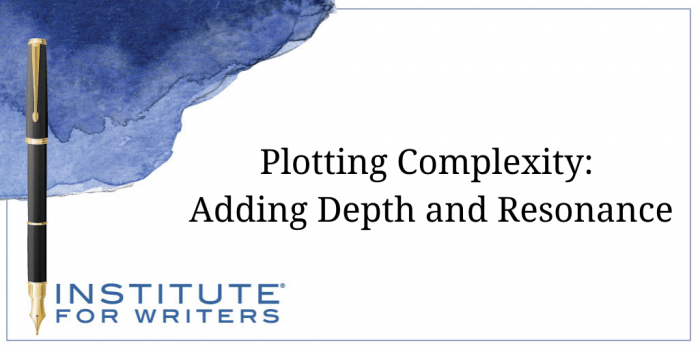1000 N. West Street #1200, Wilmington, DE 19801
© 2024 Direct Learning Systems, Inc. All rights reserved.

Conflict drives plot. When a character’s internal challenges are tested by external forces, the resulting story can be heart-warming, horrific, hilarious, or all three at the same time. But even the fluffiest of romps or the most fast-paced adventure can have unexpected depth when the action subtly illuminates various aspects of the human condition. Writers can draw on anything from the oldest myths to the latest sociological research in order to create layers of meaning and emotional resonance. Such things must be carefully smoothed into the text, of course, without slowing down the project’s forward momentum. They have to feel organic to the plot rather than like a last-minute addition.

Layering in novels can have a similar effect on a reader. But instead of only being allowed to look at a narrow but vital slice of a single protagonist’s life, readers can experience days, weeks, months, or years in the lives of one or more central characters. While short stories can have layers, novels need them. The conflict in a short story will be tightly focused, but life in even the most sparely written novel will have lots of complications: sociological, psychological, interpersonal, familial, romantic.
Layers might not be subplots, but they can certainly create them. Each subplot will have all the elements of a central plot with an inciting incident, a series of temporary triumphs and reversals, a dark night of the soul, an epiphany, a climax, and a resolution. The various subplots in a well-plotted novel will be arranged in a way so that each contributes to the climactic moment.
Surprisingly enough, there are novels out there that don’t actually have independent subplots. A close examination will show that the activities of the characters, sometimes even those of the viewpoint characters, are actually contributing to the central conflict without a well-defined arc.
Here are some of the layers you can find in The Hunger Games Trilogy that give added meaning to the brilliant plotting. Some are created by subplots; others are part of the subtext. (Spoiler alert! Spoiler alert!) An analysis of them can help you think about building depth in even a quiet, character-driven novel.
Societal: During a New York Times interview back in October of 2018, Suzanne Collins shared how she’d been wanting to continue exploring just-war theory in a new project for young readers now that her Underland Chronicles were coming to an end. While she was flipping channels between the Iraq War and various reality TV shows, she realized that a televised gladiatorial fight to the death that featured innocent young men and women annually and randomly drawn from each political district would be an excellent reason for an enslaved population to rebel.
Political: The second and third books of the trilogy explore how leaders use coercion and competitive mythmaking to push their desired outcomes and consolidate power.
Romantic: In the same interview mentioned above, Ms. Collins indicated that Peeta and Gale started out as two perspectives in her just-war debate. Peeta’s natural diplomacy contrasted sharply with Gale’s readiness to use violence. Naturally, they both evolved into full-fledged characters even as they continued to represent two sides of an argument.
Symbolic: The gold mockingjay pin, which starts out as tribute token from District 12, gradually becomes the symbol of the rebellion.
Psychological: Suzanne Collins did her research. One of my friends who’s currently serving as an army psychiatrist at a VA hospital observed that Katniss has a serious case of PTSD in the second two books. The things that she’d gone through were clearly driving her behavior and decision-making.
Familial: At the beginning of the trilogy, Katniss takes her sister’s place in the Hunger Games. Near the end of the third book, Katniss watches her sister killed in the closing minutes of the civil war. Not in the last few days. Not in the last few hours. The last few minutes.
Allusional: While the competition itself has more in common with the gladiatorial fights to the finish in the Roman Coliseum and other arenas around the empire, the idea of offering up young men and women as tribute goes back to the story of Theseus and the minotaur on the isle of Crete.
Topical: Contestants compete against each other in reality television until there’s a single winner. The Hunger Games had an interesting combination of Survivor and American Idol. Figuring out wardrobe, hair, and makeup in order to give each participant a brand is important in the latter. I have a feeling Collins kept that in mind. In fact, near the very end of the trilogy, the character who’d served as one of the gamemasters and was part of the rebellion let Katniss know that he was about to launch a singing competition. She could be a part of it if she liked. He’d send a camera crew.
Kristin Wolden Nitz has had sixteen different addresses in eight different states since graduating from college. When she tells friends and family that she’s not moving again, they laugh. Kristin splits her time between writing novels and serving as one of our instructors. Kirkus described her novel Suspect as “intriguing, suspenseful fun.”
1000 N. West Street #1200, Wilmington, DE 19801
© 2024 Direct Learning Systems, Inc. All rights reserved.
1000 N. West Street #1200, Wilmington, DE 19801
© 2024 Direct Learning Systems, Inc. All rights reserved.
1000 N. West Street #1200, Wilmington, DE 19801
© 2024 Direct Learning Systems, Inc. All rights reserved.
1000 N. West Street #1200, Wilmington, DE 19801
© 2024 Direct Learning Systems, Inc. All rights reserved.

1000 N. West Street #1200, Wilmington, DE 19801
© 2025 Direct Learning Systems, Inc. All rights reserved.

1000 N. West Street #1200, Wilmington, DE 19801
©2025 Direct Learning Systems, Inc. All rights reserved. Privacy Policy.
1 Comment